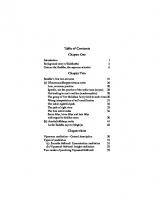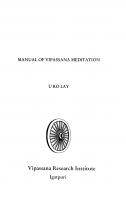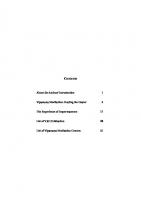Manual of Vipassana Meditation 8174142290, 9788174142290
MANUAL OF VIPASSANA MEDITATION ₹100.00 ‘Manual of Vipassana Meditation’ is a collection of lectures by Mr. U Ko Lay, stu
139 38 295KB
English Pages 200 [6] Year 2023
MANUAL OF VIPASSANA MEDITATION
₹100.00
‘Manual of Vipassana Meditation’ is a collection of lectures by Mr. U Ko Lay, student of Sayagyi U Ba Khin and a former Vice Chancellor of Mandalay University. These lectures, which have been much expanded and annotated, were given to the first year students at the International Buddhist Missionary University where U Ko Lay had acted as the Head of Department of Vipassana Meditation in the Faculty of Patipatti.
The teachings of the Buddha are based on Dhamma, the universal Truth. This manual enshrines the Buddha’s teachings in a concise format. It contains the life story of the Buddha, his teachings, explanation of the first two discourses given by the Buddha, and a general description of Vipassana meditation. This book also explains Mahasatipatthana Sutta, the great discourse on the foundations for the establishing of mindfulness.
This book is ideal for Vipassana meditators and scholars interested in the Buddha’s teachings.
Recommend Papers

File loading please wait...
Citation preview
Manual of
VIPASSANA MEDITATION
U KO LAY
Manual of Vipassana Meditation U KO LAY
Vipassana Research Institute Dhammagiri, Igatpuri 422 403
Table of Contents Chapter One Introduction Background story of Siddhattha Gotama the Buddha, the supreme scientist
1 4 6
Chapter Two Buddha’s first two sermons 21 (a) Dhammacakkappavattana sutta 26 Low, common practice 28 Ignoble, not the practice of the noble ones (ariyas) 28 Not tending to one’s welfare (anattasa½hito) 28 The group of five bhikkhus firmly held to such views30 Wrong interpretation of self-mortification 31 The noble eightfold path 32 The path of right view 33 The four noble truths 34 Sacca ñ±ºa, kicca ñ±ºa and kata ñ±ºa with regard to dukkha sacca 36 (b) Anattalakkhaºa sutta 41 As the Buddha says to Meghiya 48
Chapter three Vipassana meditation—General description Types of meditation (a) Samatha bh±van±: Concentration meditation (b) Vipassan±- bh±van±: Insight meditation Two modes of practising Vipassan±-bh±van±
50 51 51 52 53
Chapter four Mah±satipaμμh±na sutta 1. Uddeso 2. K±y±nupassan± (a) ¾n±p±napabba½ (b) Iriy±pathapabba½ (c) Sampaj±napabba½ (d) Paμik³lamanasik±rapabba½ (e) Dh±tumanasik±rapabba½ (f) Navasivathikapabba½ 3. Vedan±nupassan± 4. Citt±nupassan± 5. Dhamm±nupassan± (a) N²varaºapabba½ (b) Khandhapabba½ (c) ¾yatanapabba½ (d) Bojjhaªgapabba½ (e) Saccapabba½ Dukkhasaccaniddeso Samudayasaccaniddeso Nirodhasaccaniddeso Maggasaccaniddeso Satipaμμh±nabh±van±nisa½so Conclusion List of books for further reading Appendix
57 58 59 59 62 63 63 66 66 70 72 73 73 76 76 79 83 83 88 95 102 106 111 115 116
List of VRI Publications List of Vipassana Meditation Centres
120 123
Preface This Manual is a collection of my lectures, which have been much expanded and annotated. They were given to the first year students at the International Buddhist Missionary University where I had acted as the Head of Department of Vipassana Meditation in the Faculty of Paμipatti. Vipassana Meditation is the unique practice taught by the Buddha. The Teachings of the Buddha are extremely vast, all enshrined in the three baskets of Tipiμaka__ Vinaya, Suttanta and Abhidhamma. The immense wisdom of the Buddha has given us this tremendous wealth of the knowledge of the Truth, considered from all aspects and angles. The same immense wisdom of the Buddha has also put all of his teachings in a nutshell, as it were, in three neat verses. I am referring to ov±da p±timokkha g±th±s which give a brief summary of his teachings. Let me now present to you the three verses of this Ov±da P±timokkha G±th± ; 1. ‘khant² parama½ tapo titikkh±, nibb±na½ parama½ vadanti buddh±; na hi pabbajito par³pagh±t², na samaºo hoti para½ vihe¼hayanto. Forbearing Patience is the highest moral practice “Nibb±na is supreme” say the Buddhas. A bhikkhu does not harm others. One who harms others is not a bhikkhu. 2. ‘sabbap±passa akaraºa½, kusalassa upasampad±; sacittapariyodapana½, eta½ buddh±nas±sana½. Not to do evil, to cultivate merit (good deed), to purify one’s mind. This is the teaching of the Buddhas.
3. ‘an³pav±do an³pagh±to, p±timokkhe ca sa½varo; mattaññut± ca bhattasmi½, pantañca sayan±sana½; adhicitte ca ±yogo, eta½ buddh±nas±sanan’ti. Not to revile, not to do any harm, to practice retraint in the Fundamental Precepts, to be moderate in taking food, to dwell in a secluded place, intent on higher thoughts. This is the teaching of the Buddhas. How short, how simple, how easy to understand from this clear concise exhortation of the Buddhas; we know as true disciples of the Buddha, what we should avoid, restrain doing; and what we should assiduously cultivate and practice. Simple yes; but the big question is, how to put this clear, concise advice of all the Buddhas into practice, into daily practice, into lifelong practice, how to make the practice as part and parcel of our life. Nearly all religions teach their respective followers to avoid evil and cultivate good deeds. But none of them shows the method of how to avoid evil and cultivate good deeds. It is unique that Buddhism alone teaches how to put into practice what it teaches. The teachings of the Buddha are known as Dhamma which is universal, ethical and moral Truth. This Dhamma is not just to be preserved in books; nor is it to be learnt for academic games of discussions, disputations, arguments and dissensions. It is to be learnt to be put into practice in the course of daily life; it is to be studied, to be practised and above all, to be realized. The ultimate goal of the Dhamma is the realization of the Four Noble Truths. The sole purpose and aim of this Manual is to help the serious students to find peace and happiness and ultimate realization of Nibb±nic peace by means of Vipassana Meditation. In the rapidly changing world of material development at the sacrifice of moral and spiritual advancement, Vipassana Meditation practice, still being kept in its pristine purity in Myanmar, has a definite role to play for the promotion of welfare, peace, harmony and happiness of mankind.






![Karma and Chaos: New and Collected Essays on Vipassana Meditation [1 ed.]
9781928706694](https://ebin.pub/img/200x200/karma-and-chaos-new-and-collected-essays-on-vipassana-meditation-1nbsped-9781928706694.jpg)
![PRAYER AND MEDITATION MANUAL [2 ed.]](https://ebin.pub/img/200x200/prayer-and-meditation-manual-2nbsped.jpg)

